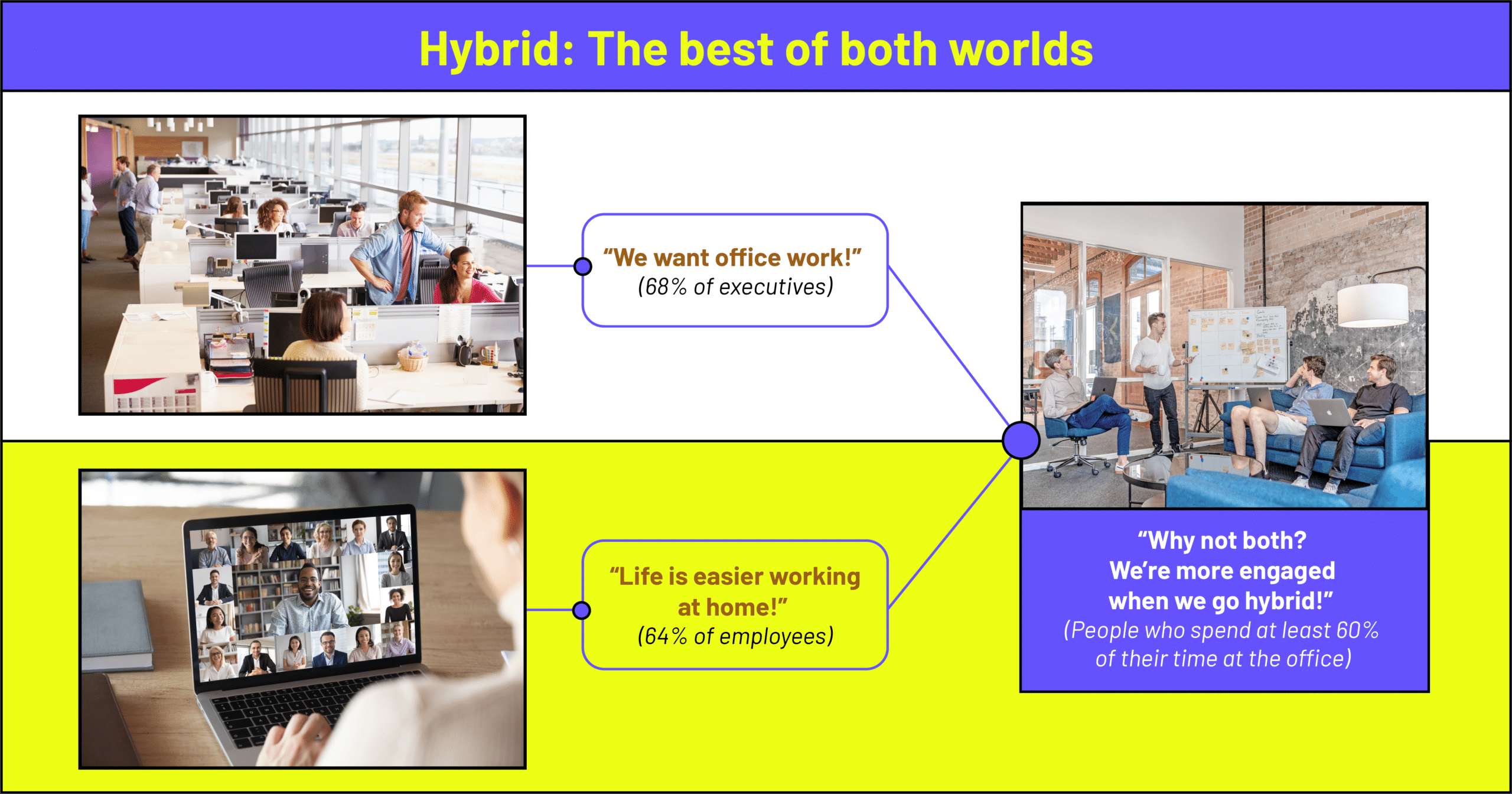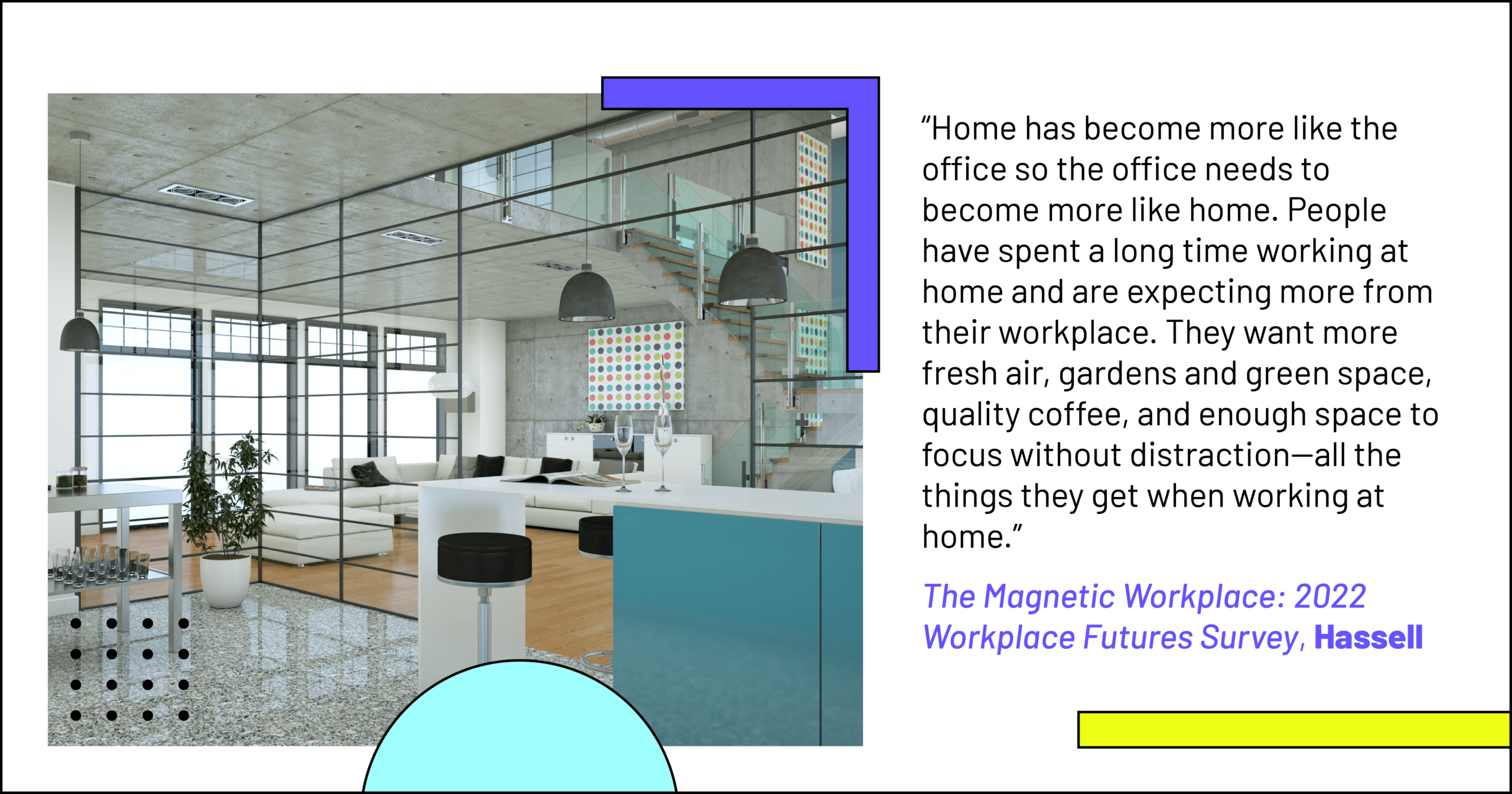As more and more employees prefer hybrid working arrangements, understanding how to optimize and design spaces that support this kind of work has become a top priority for achieving the workplace of the future.
The “RTO” conundrum
The term “Return to Office” (RTO) has become another ubiquitous term cloaked in ambiguity as companies everywhere try to adapt how they work.
The pandemic forced companies around the world to adjust to new routines. For many, virtual meetings have taken the place of conference rooms and employees everywhere are using online tools like Miro to collaborate remotely.
While the push to remote work was sudden, drastic, and unexpected, many employees have become content and happy with working remotely, and proved that productivity can be achieved without a traditional office setting.
From the perspective of employees, working remotely has been beneficial in many ways. In a recent Pew Research survey, 64% of those forced into remote work say that it is easier to balance work life with personal life. Additionally, 44% of these workers state that working from home has actually made it easier for them to get their work done and meet deadlines, rather than making it more difficult.
This demand for flexible work options is a big deal to most employees. Roughly 60% of employees indicate that they are more likely to apply for a job with a remote work option as opposed to employment mandating their physical presence on site.
Conversely, many business leaders have contrasting opinions regarding the push for more remote work. Sixty-eight percent of executives think that their employees should be in the office at least three days a week to contribute to their company culture–making some sort of an RTO strategy a key area of focus.
This focus area isn’t arbitrary either–there is merit to getting people back to in-person settings as working totally remote isn’t perfect. In a recent Hassell survey of 2,500 office workers across the US, UK, and APAC, revealed that employees who spend 60 to 80% of their time in the office are more engaged than those who don’t.

The benefits of going with a Hybrid RTO Strategy
Hybrid is here to say and is becoming the best of both worlds in terms of keeping both employees and employers happy:
- Employees who are given the flexibility to split their time between office and remote work–as long as flexibility and autonomy are not sacrificed–are more likely to stay with a company and not resign.
- Employers who provide flexible hybrid working arrangements can not only reduce employee turnover but also increase employee engagement and enhance the trust between them and their employees.
While slapping the term “hybrid” on your workplace strategy won’t be enough pull off a successful hybrid RTO–companies should be wary of hybrid work policies with rigid mandates and “strings attached”–understanding how to optimize space for hybrid work, is the first step pulling off a hybrid work strategy.
It’s also how you turn stagnant offices into dynamic employee “magnets.”
Making your hybrid office an employee magnet
While there is no one-size-fits-all approach to office design and workplace strategy, making your workplace an employee magnet–a space that allows for flexibility, autonomy, productivity, and amenities–has become the best route to executing a hybrid office.

Increasing office engagement won’t happen overnight and it certainly won’t happen by way of forcing people back–rigid mandates and attendance requirements continue to lead to high resignation rates. However, by taking the term “magnetic office” literally, it reveals that companies must find ways to attract people to the office.
According to the “Magnetic Workplace Survey,” a person’s commute has the most influence over whether or not they’ll go into the office. While amenities, in aggregate–such as ample space without distractions, physical/mental safety precautions, fresh air, green spaces, free food and beverages, etc.–make commuting to the office compelling, it’s important to take utilization data and combine it with employee feedback.
Data, data, data: The keystone for optimizing a hybrid workplace
Optimizing space for hybrid work is a new muscle for a lot of companies.
Many believe their spaces are being used to their full potential; however, many are measuring spatial “success” with old metrics that are often too broad to measure actual utilization.
For example, conference rooms. As noted by Work Design Magazine, many occupiers assume that if conference rooms are booked, that they are being used to their full potential.
This isn’t necessarily true.
Looking at conference room book rates is important but are the people who booked it actually showing up? If so, what’s the occupancy rate of the conference room? If the conference room can hold up to 15 people, but on average only three people are using it, not only is space being wasted but utilization is being greatly misrepresented.
Or perhaps conference rooms are always booked and in high demand. If you just look at booking rates, it might lead you to believe that you need more conference rooms.
Once again, the devil is in the details.
Did Sue book a 10 person conference room for three hours to hold a three hour long meeting with nine of her colleagues? Or did she book it because her company over-indexed their office with social/collaboration spaces? Making quiet areas for focus a sparse commodity.
Getting granular with data is the keystone for understanding how to optimize space–especially when it comes to hybrid-enabling offices. Occupiers must know as much as they can about employee behaviors, habits, movements, and sentiments of space.
We go more into detail about capturing employee behavior to inform space planning.
Tying together utilization data, employee feedback, and workplace strategy

As you look to reanalyze, redesign, and reimagine your office to be a hybrid enabling workspace, leveraging Saltmine will allow you to analyze, track, and interpret relevant data with actionable insights so you can create spaces people love.
Saltmine allows businesses and their workplace teams to visually feed qualitative (employee feedback data) and quantitative (utilization data) seamlessly into their workplace strategy and design.
If you want to learn more about how a Saltmine customer acted on data with confidence, benchmarked and redefined ratios, and better prepared for the future using Saltmine, click the image below.
Enjoying our blog? Be sure to subscribe to stay up-to-date on Saltmine's original content with the form below!
 by
by 